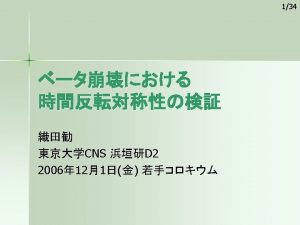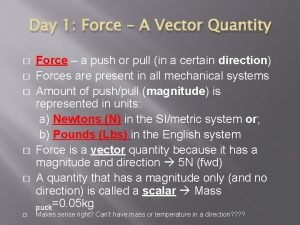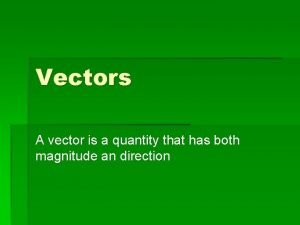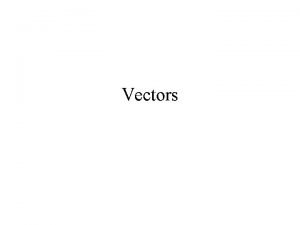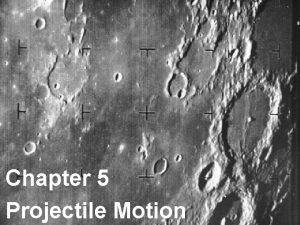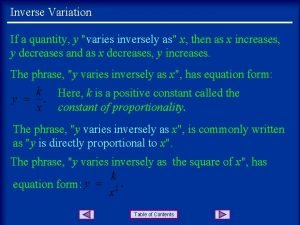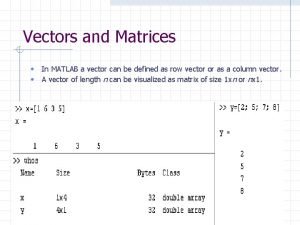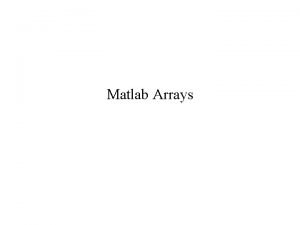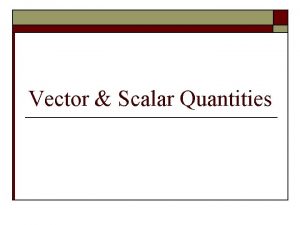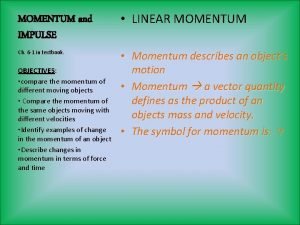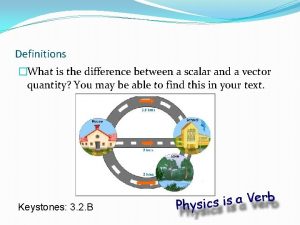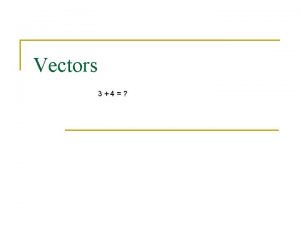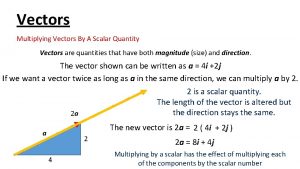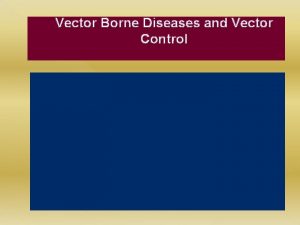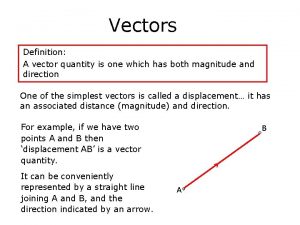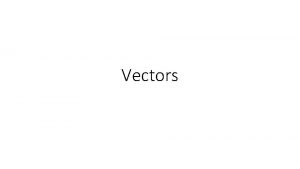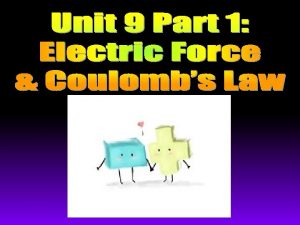Vectors A vector is a quantity which has


















- Slides: 18

Vectors A vector is a quantity which has a value (magnitude) and a direction. Examples of vectors include: Displacement Velocity Acceleration Force Weight

Resultant • The resultant is the sum of the vectors. There at least 3 ways to find the resultant. 1. The head-to-tail method. 2. The parallelogram method. 3. The sum of horizontal and vertical components.

The head-to-tail method. • Connect every vector from head-to-tail. Then connect the tail of the first vector to the head of the last and that is your resultant. • Ex. A man walks 4 meters east and then 5 meters at 45° North of East.

Step 1 • Draw the first vector to scale. • Label the vector and scale. Scale: 1 m = 1 cm 4 m East

Step 2 • Draw the next vector to scale. • Label the vector and scale. Scale: 1 m = 1 cm N ° 5 4 m East 5 m @ 4 E f o

Step 3 • Draw the resultant to scale. • Label the vector and scale. Scale: 1 m = 1 cm @ m 2 12. 5 2 ° f. E o N 8. 3 4 m East N ° 5 5 m @ 4 E f o

Method 2 • Take the vector given and make a parallelogram with them. Note: it only works with two vectors. Then connect the ray that bisects, from your origin corner to the ending corner.

Step 1 • Draw the first vector to scale. • Label the vector and scale. Scale: 1 m = 1 cm 4 m East

Step 2 • Draw the next vector to scale. • Label the vector and scale. Scale: 1 m = 1 cm 5 m @ N ° 45 of E 4 m East

Step 3 • Draw the same vectors connected to the opposite previous vectors to make a parallelogram. Scale: 1 m = 1 cm 5 m @ N ° 45 of E 4 m East

Step 4 • Draw the bisecting ray • Measure the angle with a protractor. Scale: 1 m = 1 cm 5 m @ N ° 45 of E f. E 12 m. 32 8 4 m East @ 25. o °N

Method 3 (MATH) • Take each vector and find its horizontal and vertical components. All components going up and right (North and East) are positive. All components going left and down (West and South) are negative. • Make a grid and then add all components. • Horizontals are Cos θ. • Verticals are Sin θ. • If you have a vector without an angle put in a 0 for the other component.

Grid Layout Horizontal Vertical + 4 m East + 5 m Cos 45° E + 0 m North + 5 m Cos 45° N

Grid Layout Horizontal Vertical + 4 m East + 5 m Cos 45° E _________ +4 m + 3. 53 m + 0 m North + 5 m Sin 45° N _________ +0 m + 3. 53 m

Grid Layout Horizontal Vertical + 4 m East + 5 m Cos 45° N of E _________ +4 m + 3. 53 m _________ +7. 53 m East + 0 m North + 5 m Sin 45° N of E _________ +0 m + 3. 53 m _________ +3. 53 m North Now you have a vertical and a horizontal component. Do Pythagorean Theorem and Trig to get your resultant.

Pythagorean Theorem and Trig a 2 + b 2 = c 2 7. 532 + 3. 532 = c 2 8. 32 m = c

Pythagorean Theorem and Trig a 2 + b 2 = c 2 7. 532 + 3. 532 = c 2 8. 32 m = c Tan-1 (y / x) = θ Tan-1 (3. 53 / 7. 53) = θ 25. 12° N of E = θ

Pythagorean Theorem and Trig a 2 + b 2 = c 2 7. 532 + 3. 532 = c 2 8. 32 m = c Tan-1 (y / x) = θ Tan-1 (3. 53 / 7. 53) = θ 25. 12° N of E = θ So your answer would be: 8. 32 m @ 25. 12° N of E
 Scalar quantity and vector quantity similarities
Scalar quantity and vector quantity similarities Vector quantity
Vector quantity Speed has magnitude only
Speed has magnitude only Scalar quantity
Scalar quantity A force is a vector quantity because it has both
A force is a vector quantity because it has both Scalar vs vector
Scalar vs vector A vector is a quantity that has
A vector is a quantity that has Adding multiple vectors
Adding multiple vectors Aristotle view of projectile motion
Aristotle view of projectile motion Quantity y varies inversely as quantity x.
Quantity y varies inversely as quantity x. Matlab vector of vectors
Matlab vector of vectors Matlab vector of vectors
Matlab vector of vectors Vector quantity
Vector quantity Momentum is a vector quantity
Momentum is a vector quantity A 2250 kg car traveling to the west slows down
A 2250 kg car traveling to the west slows down Centripetal acceleration
Centripetal acceleration Scalar and vector quantity difference
Scalar and vector quantity difference Acceleration vector quantity
Acceleration vector quantity Vector trigonometry
Vector trigonometry



